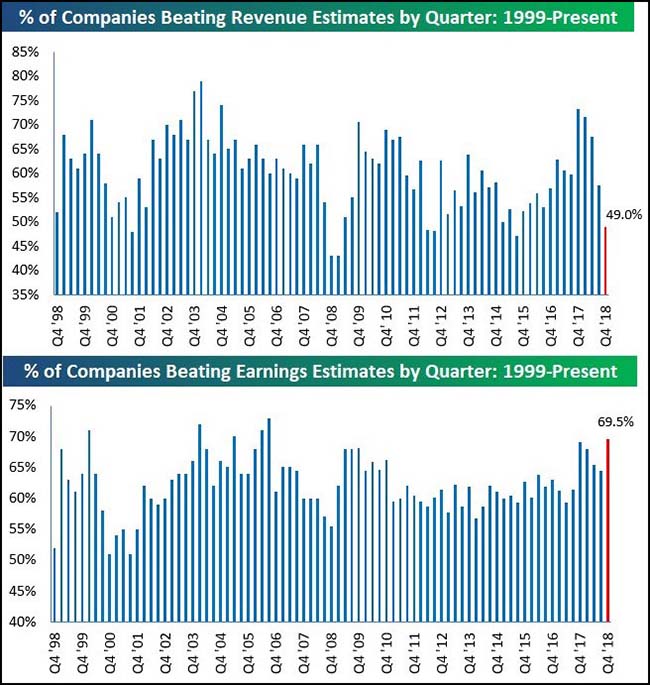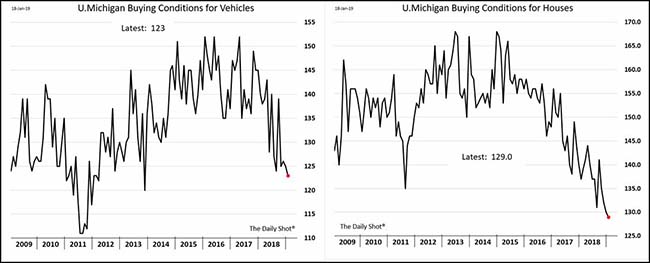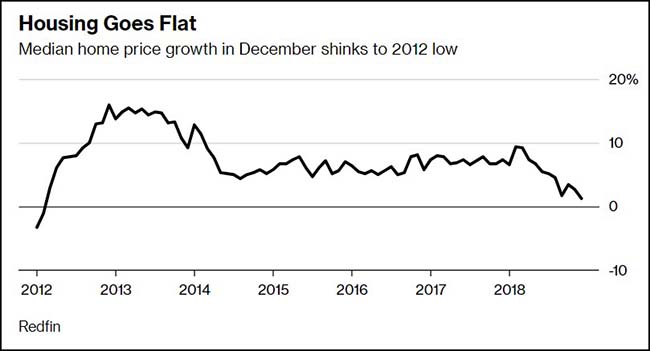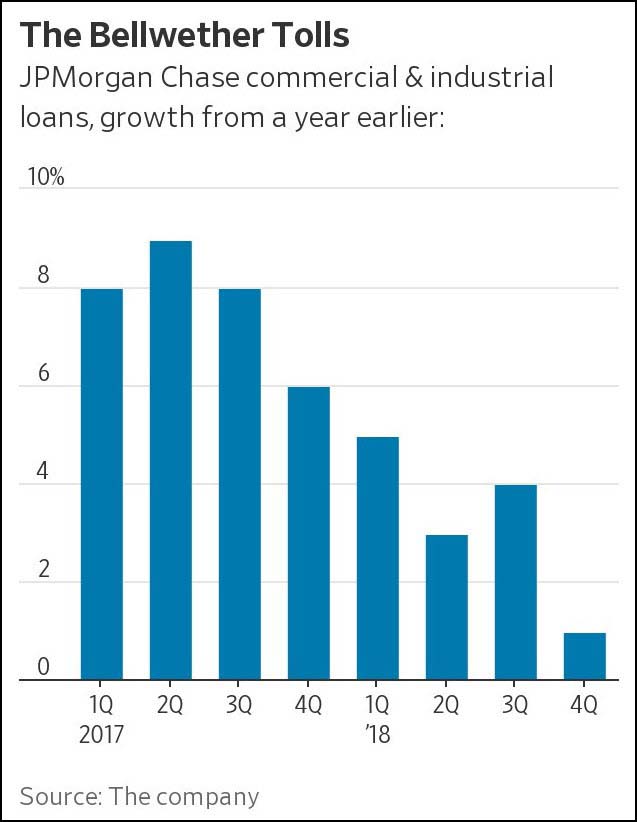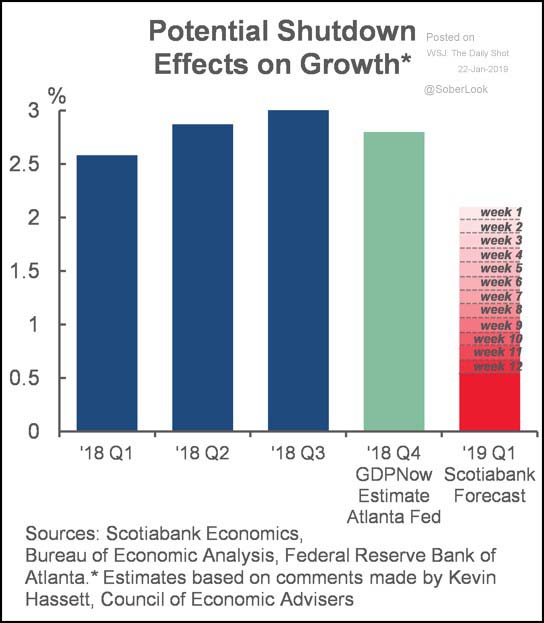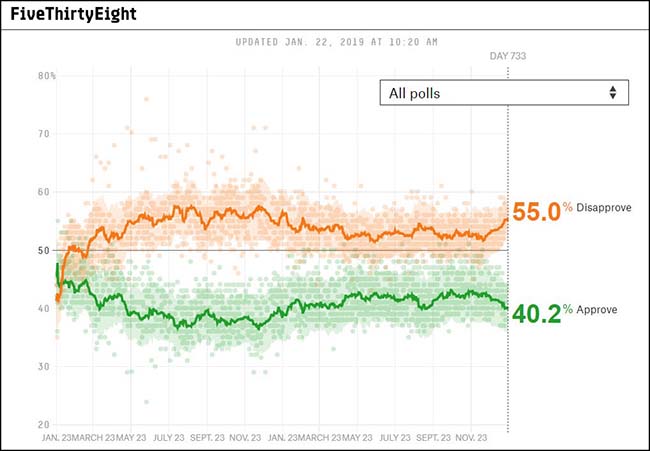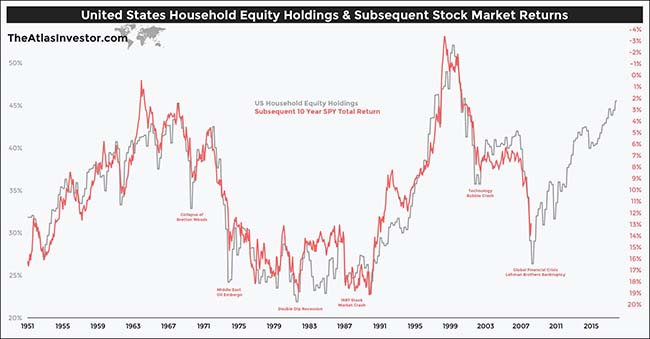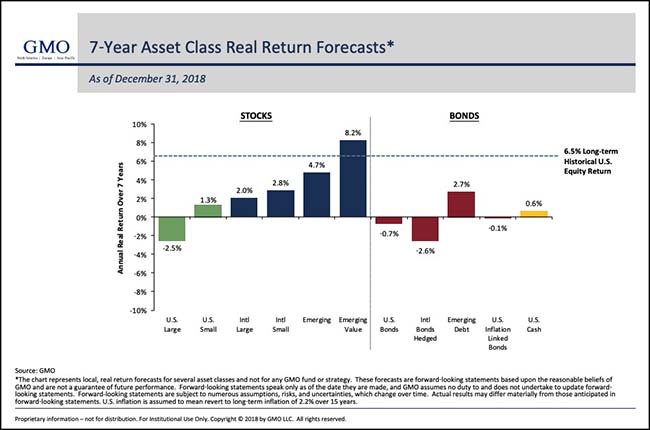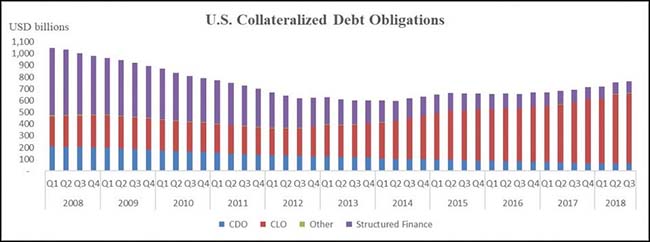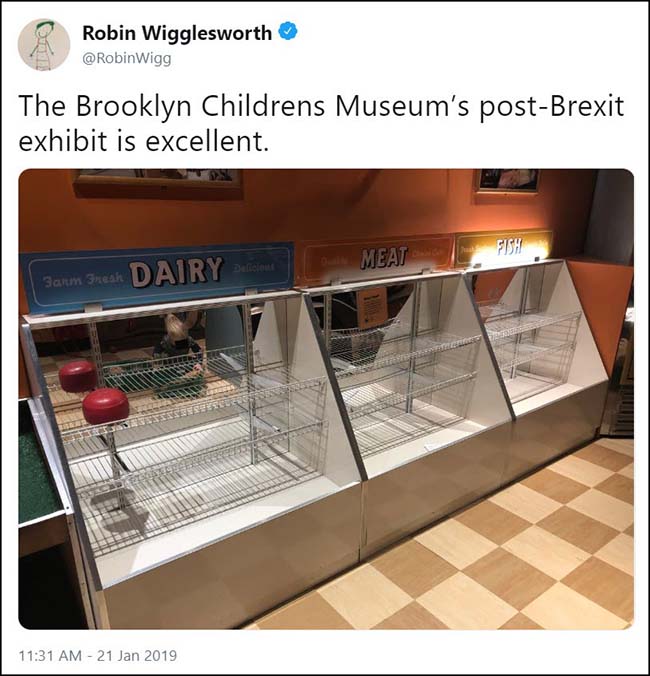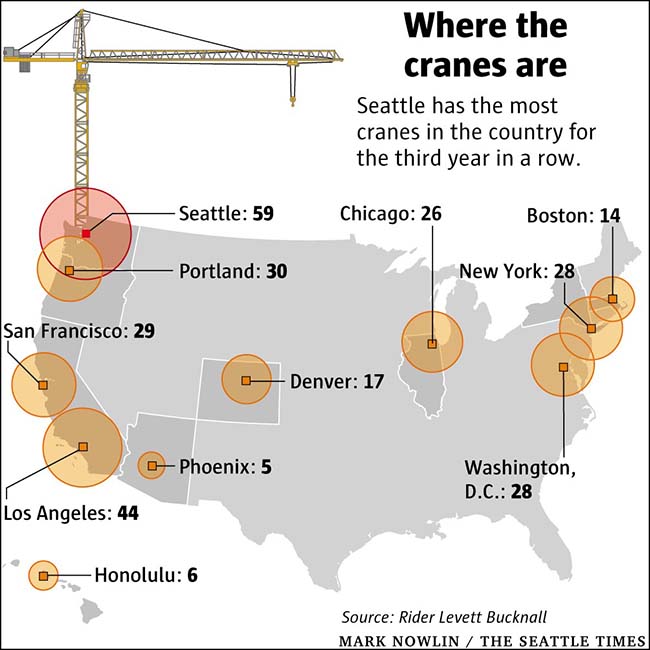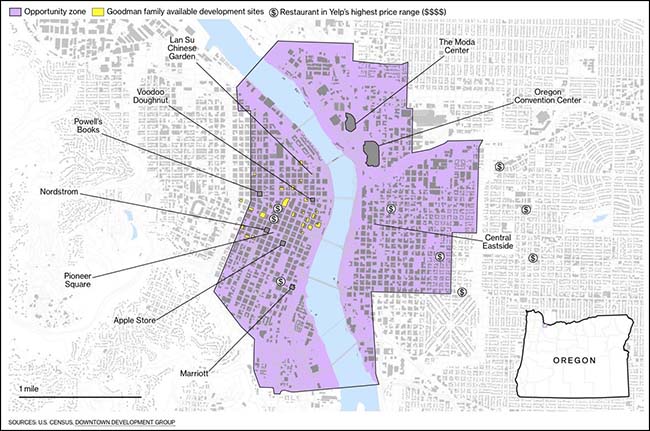by Blaine Rollins, CFA, 361 Capital
The weather. The government. China trade talks. Economic optimism. FOMC rate hikes. You pick it and it’s frozen. The good news for the equity and credit markets is that the first week of corporate earnings releases calmed the worst fears. While reported sales disappointed, at least companies were able to find some spare cents in the cupboard to meet or exceed the bottom line. This helped stocks to its fourth winning week.
But now the S&P 500 is trading at 15-16x the 2019 earnings estimate. I fail to see how it can trade up to 17x and beyond without help from top line growth re-accelerating. We know that the White House remains very sensitive to the price of the stock market as they continue to float China trade trial balloons and put Larry Kudlow on TV anytime the market falls one percent.
But at the same time, they are not progressing with trade talks and don’t seem to really care about the government shutdown. Meanwhile the forward economic puzzle pieces that we are able to assemble are forecasting a more dismal picture of 2019: shortfalls in University of Michigan consumer sentiment, existing housing sales, Empire Fed manufacturing, S.Korean trade data and any China datapoints.
I have to point out that the Philly Fed number was a good one (but remember that survey likely reflected when the Eagles were still in the playoffs).
So along with the weather, my willingness to take risk right now remains frozen. The buying volumes in this four-week bounce have been pathetic versus the amount of selling that we saw in the month of December.
Again, I don’t have to take risk so I am going to sit and wait for the news flow and the outlook to improve. I am happy to pay higher prices for a better environment than risk losing if the current trends persist.
To receive this weekly briefing directly to your inbox, subscribe now.
Typical of being late in the economic cycle: Revenues miss while Earnings hit…
@bespokeinvest: The revenue beat rate for Q4 earnings is sitting below 50% at the moment while the EPS beat rate is at 69.5%. Not good. $$
If you are a global industrial that sells into consumer demand, then Stanley is a good proxy for your trends…
Stanley Black & Decker makes everything from power tools and lawn-care equipment to vacuums and toasters. Its portfolio includes several staples of the hardware aisle such as DeWalt, Porter-Cable, Mac Tools and the company’s namesake brands, Stanley and Black & Decker. It also provides commercial security, manufacturing and construction services. Mr Loree said the tools and automotive markets began to lose momentum in the third quarter due in part to interest rate rises by the Federal Reserve that hurt real estate and car buying.
Meanwhile, economic and political turmoil in Germany, the UK and Italy have created challenges in Europe, he added. Chief financial officer Donald Allan Jr. noted that negative impacts from higher commodity prices, tariffs and currency fluctuations dragged on operating margins in the tools and storage business during the fourth quarter. They also cautioned that Stanley Black & Decker will see continued pressure on margins as the company balances sales volume with raising prices to offset rising costs.
NIDEC is a key Asian tech player. Their quarterly datapoints were concerning…
* “China’s slowing economy is also discouraging consumption faster than anticipated. Nidec’s customers there cut car-related production by 30 percent in November alone as the world’s biggest auto market sputtered, executives said. Chinese vehicle sales fell in 2018 for the first time in 28 years as consumers worldwide balked at buying new cars in the face of growing economic uncertainty.
* “The electronics giant, which employs more than 100,000 globally, cited an “adverse ripple effect” from the U.S-China dispute. “The company has experienced a decline in customer demand beyond its prior expectations and the resulting inventory adjustments since last fall,” Nidec said in a statement.
(MorganStanley)
And the University of Michigan Consumer Confidence survey is getting dismal for auto and housing…
The government shutdown is going to make these figures worse before they get better.
Speaking of home sales, prices are about to flip negative…
Home sales in the U.S. slumped in December, while prices inched up slightly, marking the smallest annual increase since the end of the last housing crash in 2012, according to data from brokerage Redfin.The median home price rose to $289,800 in December, a gain of 1.2 percent, the slowest monthly pace since March 2012. Sales dropped by almost 11 percent, the biggest decline for any month since 2016, Redfin said. Previously hot metropolitan areas are cooling fast. Prices dropped 7.3 percent in San Jose, California.
J.P. Morgan is pulling back from lending to businesses as risks have risen…
JPMorgan reported growth of 1% from a year earlier in commercial and industrial loans, down from 4% in the prior quarter, which Chief Financial Officer Marianne Lake said was partly because the bank had pulled back from lending in particular areas and partly because of a general slowdown in the economy.The bank also increased loan-loss reserves in its commercial-banking book moderately. On a conference call, Ms. Lake characterized the reserve build as being in “a handful of names in a handful of sectors, nothing that points to a systematic deterioration in a particular sector.” Nonetheless, it signals increased caution by the bank that the credit cycle is set to turn following years of historically low defaults.
JPMorgan Chief Executive James Dimon was frank that the bank wouldn’t hesitate to pull back more on lending if needed. “We have no problem seeing the loan book shrink,” he told analysts. “We are not going to be stupid.”
(WSJ)
A good chart showing the effect of the government shutdown on GDP…
As we have discussed before, each week will clip GDP by about 0.1%.
Korea is a major exporter and they are showing a significant contraction…
@enlundm: Korean exports appears to have collapsed in January – bad news for global EPS growth! $KRW
A strong Fed hawk moves to the sidelines as her crystal ball goes cloudy…
“Market fluctuations as dramatic as we saw are really attention grabbers and things you look at to say, ‘Wow, what’s behind that? What’s prompting that?’” Ms. George said in an interview Tuesday in Kansas City, Mo. Ms. George said she wanted to take more time before deciding whether the economy needed higher rates.Ms. George said volatility since the Fed’s December meeting hasn’t prompted her to lower her economic forecast, but “my ears are perked up. I am thinking more about which of these downside risks could materialize.”
Other supporters of higher rates last year, including Boston Fed President Eric Rosengren and Cleveland Fed President Loretta Mester, have also said in recent speeches and interviews they are comfortable holding off on more rate rises until the economic outlook becomes more clear.
(WSJ)
Risk is bubbling among high grade corporate debt borrowers…
Or at least the remaining GOP members of Congress would want to separate themselves from these numbers and create their own path to a deal.
For last week, it was again onward and upward for the risk indexes…
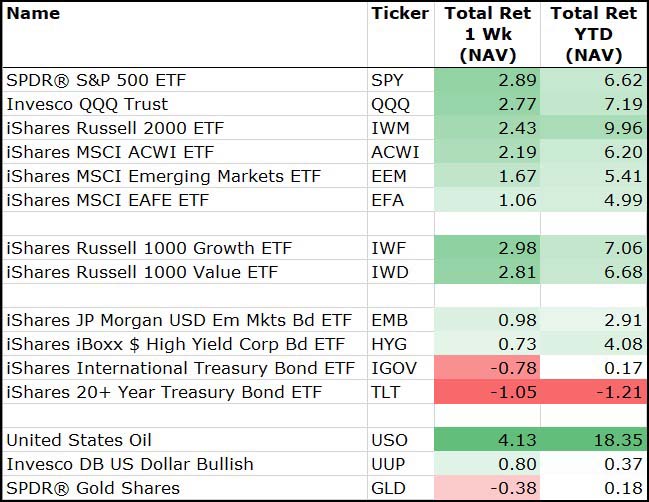
(1/18/2019)
The recovery in high yield has been incredible. I am still cautious as healthy markets do not typically act this way…
@bespokeinvest: You don’t see moves like this in high yield spreads very often. $HYG

(@bespokeinvest)
For the week, all sectors did very well…
Except for the one including a newly bankrupt utility.
A very big slate of earnings in this four-day work week…
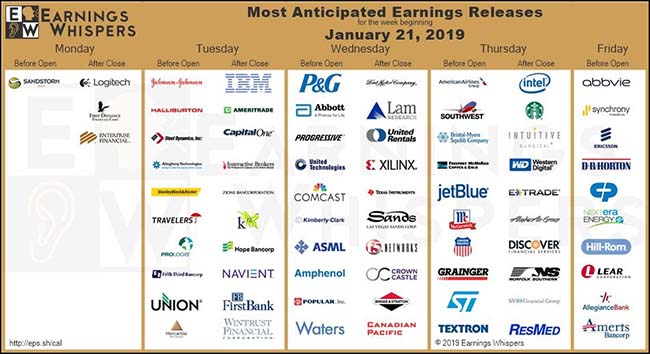
(@eWhispers)
This tightly correlated chart would suggest that your forward equity returns are going to be very disappointing…
@TihoBrkan: High exposure by the US households towards equities — like we see today — has historically been a predictor of poor subsequent returns. The correlation between this indicator and $SPY 10-year annualized return is close to 90%.
To receive this weekly briefing directly to your inbox, subscribe now.
GMO would agree that Large U.S. stocks are going to underperform cash…
And they forecast that Emerging Markets are the much better places to hunt for equity returns right now.
The next economic downturn is going to be very interesting for all packaged loan funds…
@HayekAndKeynes: No better way to create a debt bubble than to turn junk assets into AAA through securitization. In 2005 it was housing, today its corporate debt.
Paypal is amazing…
PayPal acceptance now at 82%: PayPal added another 8 merchants (net) in 4Q18, or 16 new merchants (net) in FY18. PYPL now has acceptance at 82% of the top 500 Internet retailers in the US, vs. 81% last quarter. On a volume-weighted basis (ex-Amazon), PYPL’s acceptance penetration also increased from 78% in 3Q to 79%.
(MorganStanley)
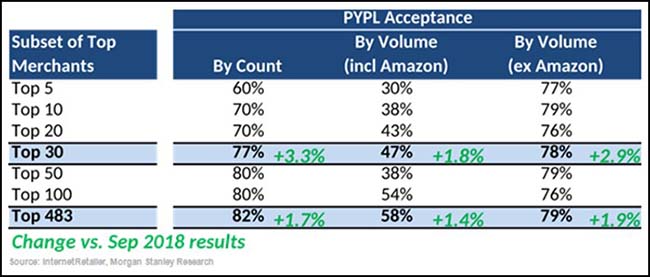
*Note: PayPal is a current holding in the Macro Opportunity Fund which is managed by Blaine Rollins.
You seriously thought that a company with more spiritual assets than physical assets would have any corporate governance?
For more than two months after employees at International Business Machines Corp. moved into a Manhattan building managed by office-space giant WeWork Cos., frequent elevator problems forced workers to climb the stairs of the 11-story building and prompted complaints to the company.
One of the landlords behind the building was no ordinary owner: It was Adam Neumann, WeWork’s chief executive, who leased the property to WeWork after buying it, according to people familiar with the situation.Mr. Neumann has made millions of dollars by leasing multiple properties in which he has an ownership stake back to WeWork, one of the country’s most valuable startups. Multiple investors of the privately held company said the arrangement concerned them as a potential conflict of interest in which the CEO could benefit on rents or other terms with the company.A WeWork spokesman said all related-party deals are reviewed and approved by the board or an independent committee and disclosed to investors. Mr. Neumann declined to comment through a spokesman.WeWork, which was recently valued at $47 billion by investor SoftBank Group Corp. , signs long-term leases for office space with landlords, then subleases the space on a short-term basis to companies. Mr. Neumann, the 39-year-old executive who founded WeWork in 2010, is WeWork’s largest individual shareholder and has voting control over the company.(WSJ)
The Brexit talks, arguments and sword pulling from a stone continues…
Sounds like the same reason that The North Face decided to move to Denver…
Davis Smith, co-founder and CEO of Cotopaxi, an outdoor gear and apparel company, offers a glimpse of why Utah’s economy is booming.Mr. Smith said he considered launching the company in Seattle or the San Francisco Bay Area before deciding nearly five years ago to base it here, partly because of the quick access to top-notch ski resorts and bike trails, but mostly because of the young, growing and well-educated population.
“There are 200,000 full-time students that live within a one-hour radius of our office here in Salt Lake,” said Mr. Smith, whose company employs 85 workers. “These are our customers. These are people that love the outdoors….This is a great talent pool to be hiring from as well.”
Utah has had the fastest-growing labor force of any U.S. state since January 2010—a key ingredient for economic growth and one that provides an example for the nation as a whole as it seeks to fuel a more rapid expansion.
Economic growth is a function of gains in the number of workers and their productivity. More workers means more output, income and consumer spending. These trends, in turn, attract more employers and workers, fueling a virtuous cycle of growth.
(WSJ)
Speaking of growth, time for a big crane update…
Seattle still has more construction cranes than any other U.S. city, as developers keep building high-rises in the fast-changing city.The city of Seattle has 59 cranes sprouting out across the skyline, down slightly from the 65 counted six months ago. But that’s still 15 more than Los Angeles, the next-highest city.
Outside of a lull a year and a half ago, Seattle’s crane count has hovered around 60 since 2016, when it took over the national lead in cranes.
The new numbers come from Rider Levett Bucknall, which counts cranes in big cities across the world twice a year.
If you know Portland, Oregon, then you know that this is a massive waste of your Federal Tax dollars. Just take a look at the crane chart above to show you that downtown Portland doesn’t need one dollar of subsidy.
Portland is about to see a flurry of construction because of a provision in the 2017 tax overhaul that led to the creation of more than 8,700 “opportunity zones” across the country—areas that, in theory, have been ignored by investors and need generous tax breaks to catch up. But Oregon did an audacious thing: It selected the entire downtown of its largest city to be eligible for the law’s suite of benefits, as well as neighborhoods such as the Pearl District, where new high-rises loom over old industrial spaces converted into “creative” offices and boutique furniture stores sit near juice bars serving açai bowls. The Central Eastside, an area that Portland’s alt weekly crowned the city’s “best food neighborhood,” is also included.
That’s turning this city of about 650,000 into a microcosm of what critics see as one of the biggest problems with opportunity zones: Among a nationwide patchwork of struggling areas, there are a small number of thriving communities that may draw an outsize share of investors’ cash. In some cases, the law may boost returns on investments that would’ve happened anyway. Some projects “could get more money than entire states,” says Brett Theodos, a senior researcher at the Urban Institute who has studied the policy.
“People try to put us d-down”…
That is fine CBS because my Generation doesn’t watch your Network…
The changing global climate is turning Germany into a wine mecca…
“It’s not just good,” said Roman Niewodniczanski, one of Germany’s most celebrated vintners and the owner of Van Volxem. “It’s grandiose!”What proved to be the country’s hottest, driest spring and summer on record were disasters for many German farmers, river boat captains and foresters. But they were a blessing for winemakers, leading to a record harvest — Mr. Niewodniczanski estimates his output will be up 20 percent or more on last year — while also imparting a high must weight: the all-important measure of a grape’s sweetness…
As exceptional as 2018’s harvest looks, it’s also a sign of how much conditions have changed and are changing for the German wine industry.
“We are the big winners from climate change,” said Dirk Würtz, a vintner and wine journalist. “I know it’s disgusting to say, but it’s the truth.”
Just as they have elsewhere in Europe, summers in Germany have been steadily getting warmer and longer, leading to grapes that ripen sooner and more reliably.
(NYTimes)
Finally, if you are a Financial Advisor looking for a great new client, make Domino’s Pizza carry-away your next meal…
@BluegrassCap: DPZ has almost 300 franchisees doing $900k of annual EBITDA from a single location; franchisee ROIC must be insanely high






